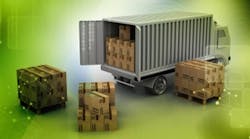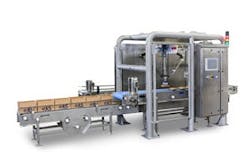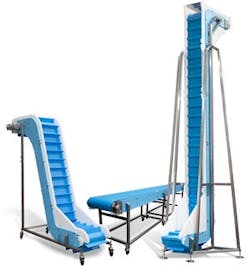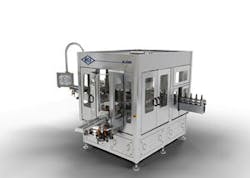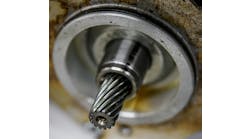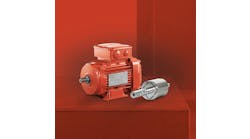Mike Bacidore is the editor in chief for Control Design magazine. He is an award-winning columnist, earning a Gold Regional Award and a Silver National Award from the American Society of Business Publication Editors. Email him at [email protected].
Packaging and conveyance machine builders face increasing needs for speed, flexibility, validation, data, and reliability. New technology has enabled new options, but machine builders are discovering ways to enable new systems that weren't even conceivable 10 years ago. We gathered input from a variety of exhibitors at Pack Expo 2014, which brought approximately 50,000 attendees to McCormick Place in Chicago and found out what technology is empowering them to design these new innovations and what challenges they're facing from end users.
Participants include Craig Souser, president and CEO of JLS Automation in York, Pennsylvania; Ted Geiselman, president of Weiler Labeling Systems in Moorestown, New Jersey; Mike Krummey, electrical engineering manager, and Marc Willden, vice president, general manager, at Matrix Packaging Machinery, in Saukville, Wisconsin; Paul Kuharevicz, engineering/R&D manager at Dynamic Conveyor in Muskegon, Michigan; and Jack Chopper, chief electrical engineer at Baltimore-based Filamatic.
Krummey: Our new machine, the Morpheus, is a departure from what we've done in the past, with respect to controls. Typically we've used PLCs and worked around some of the limitations when it came to data gathering and data porting. With this machine, we've gone into PC-based controls. One of the things, as an OEM, that I've always attempted to do is use the most cost-effective PLCs to provide accurate motion control for our machinery. The world of PC-based control has changed a lot of the way that we think. With increased scan times and the availability of the EtherCAT system for control of the motion axes, we have opened up an entirely new world of possibilities. As an OEM, you're always conscious of your creeping costs on these control platforms.
The beauty of a PC-based control system is, next year, that PC that you're using is either going to cost less with the same features or going to cost the same with increased memory and better scan times. This is a perfect world for an OEM to be in when it comes to designing long-term solutions for customers. Of particular interest is the EtherCAT network system. So far, this has been very proven for everyone who has used it to be the best motion control network. It has allowed us here at Matrix Packaging to provide a very innovative solution for a continuous motion machine.
Thankfully, we've partnered with a very capable supplier, Beckhoff Automation, and they have helped us to design a solution for this line of machines. Typically we've been limited to producing only intermittent machines. We're looking forward to a future with more data available for customers to more intelligently run their operations. The natural ability of PC-based controls to provide this information in a Windows environment is a good fit for more customers who want to start off with just some of the basics and then eventually want to move into a more complicated type of data reporting. We believe that the PC-based architecture is the future for automation in this country.
See Also: Machine Controls Change What's Possible With Labeler
Figure 1: JLS Automation’s Osprey Case Packaging System with Package Integrity Validation Technology (PIVT) using ABB Robotics was one of the new machine innovations exhibited at Pack Expo 2014.
Souser: The Osprey Case Packaging System is unveiling PIVT (package integrity validation technology), a family of technologies designed to test leaking in packages that are vacuum-packaged (Figure 1). We have a system designed for meat, dairy, and frozen food markets that deals with high sanitation, irregular flow, random orientation of packages and loads them into cases very reliably, and, in this instance, makes sure they don't leak. That's the bottom line. When a leaking package is detected, it's dropped and goes right off the end of the conveyor.
Kuharevicz: One of our new conveyor lines, the DynaClean, is a new innovation relative to sanitary food design conveyance (Figure 2). We don't use stainless steel, and that is a conscious choice. We are known as a modular conveyor manufacturer. We have joints that allow for relatively easy expansion of the system. This show system is only 8 ft high, but it's typical to go 20 ft high for form fill seal systems. As the conveyor gets taller and taller, our motor choices change. We usually right-size the motor. We use a variety of motors. They're all NEMA 4X. We choose to sell the correct size motor depending on the size of the conveyor. One of the more interesting features of our conveyor is that we don't use the buckets. We tend to use a solid belt that has no joints or seals and has a lot less surface area, which makes it a lot easier to clean. All of our conveyors can be broken down with just one tool.
We also use a NEMA 4X control that is dovetail-mounted so that during cleaning it can be moved out of the way and cleaned separately and you can get behind the dovetail and clean. One of the other motors we use is a drum motor. The teeth, the lagging, are cut right into the motor. One of the reasons to use this motor is for hygienic purposes. Once the belt is off, this motor simply picks up and can be moved and cleaned away from the conveyor, and the conveyor itself can be sanitized throughout. So, for some applications the drum motor is the way to go, versus an externally mounted motor.
Figure 2: The modular design and height flexibility of Dynamic Conveyor’s DynaClean can affect motor choices.
Geiselman: The RL-840 is our new cut-and-stack labeler (Figure 3). It's a brand-new technology collaboration with NuLabel Technologies. They've developed an activatable adhesive that is applied to the back of the raw paper to make cut-and-stack labels and then is activated with a proprietary spray. We have exclusive rights to develop new machines with that technology, and we've done that with our rotary machine. It was a match made in heaven because we've been developing rotaries for more than 20 years in the pharmaceutical industry and are a leader in that industry for pressure-sensitive labeling. But we haven't had anything in the cut-and-stack arena, and we didn't want to go into that without having something special. With NuLabel Technologies, we have that.
They look like traditional labels on a beer bottle, but these labels were applied with no glue. To make this possible, we have to have a machine with excellent controls. To do that this time, we turned to B&R controls because, from a motion perspective, they have a low-cost stepper solution for us that we can put in instead of servos. That gives us a price point where we can be competitive with traditional machines, only much more capability to be able to rotate the bottle, specifically to wipe down the label in a way that we need with the stepper-motor motions, addressable from the HMI. Just plug in a recipe of choice. In addition, we have laser printing that we do on the bottle label with a Domino laser on this machine. It's super-critical to do that accurately with super-fast communication. With PowerLink from B&R, we're able to trigger this laser accurately and phase it wherever we want on the bottle to move that print around, as required.
Figure 3: The RL-840N can rotate bottles to wipe down the label in the necessary way using stepper-motor motions, addressable from the HMI.
Willden: We focus on flexible package machinery, specifically vertical form fill seal. The Morpheus represents our new generation of machine. It provides a new level of flexibility that other machines don't have. One of the challenges we have is a lot of companies are packaging a wide range of products, particularly contract packagers might be working with General Mills one week, and they might get a contract from Frito-Lay six months later, and they need equipment that can adapt to those varying needs. That's a challenge. The Morpheus addresses some of those issues. A lot of vertical form fill seal packaging machines operate in intermittent motion fashion, but there are times when you want to run higher speeds and the sealing time on the film may require something more than just coming closed and waiting for the film to set up before you open up the jaw. With a continuous motion machine, we can actually seal the film while we're moving it. That may not seem like a big deal. But the ability to have more time to be able to dwell and get that seal properly set up means, for a lot of applications, we can deliver a much higher-speed machine. A lot of this has been enabled with the new generation of controls. We work very closely with Beckhoff Automation on this machine.
The backbone is all EtherCAT technology, meaning that every device on the network has the ability to communicate with the controller. It allows us to bring in a lot of data from all of those devices and coordinate it. The great thing about all of this though is that we've utilized One Cable Technology, which reduces the number of cables we're using to connect all of these devices. It allows us to take care of power, machine control and data acquisition over one cable, so we can do all of that without having wiring all over the machine. We use Beckhoff servos pretty extensively throughout the machine to provide the motion control that we need. We're tied into the Beckhoff controller, which takes advantage of the TwinCAT system. It's a Windows-based system, but with TwinCAT there is an abstraction layer that is between Windows and the hardware that really solved a lot of problems created by Windows. We know that in certain circumstances Windows isn't completely stable. We also know that Windows is not particularly deterministic. If we don't need high-speed performance, maybe that's not a huge deal. But, in our world, things have to happen fast.
This machine might be producing 225 bags/min. There's a lot of motion going on, a lot of coordination going on, and you can't accomplish that unless you've got a very deterministic system and a very fast system. The TwinCAT layer provides that. It allows us to know exactly when certain operations are going to be executed, and we know it's going to be stable, even if Windows loses its mind temporarily. The machine is still going to function very, very well.
Chopper: Flex packaging refers to the ability to change over different products, different sizes, different fill technologies, different capping technologies and cartoning technologies. The challenge for the OEM in that regard is being able to provide a system that doesn't end up being a Swiss-army-knife solution. What we want are solutions that are robust for every individual product, and yet robust enough to handle future products that maybe we don't have defined, maybe we don't know about and maybe we can't predict. As an OEM, we want to make the efficiencies, make the changeovers, make the usability and make the diagnostics as robust as we possibly can, so the products you make now are running extremely well.
The difficulty is figuring out whether we picked the best solution. The only tools we have are our abilities to test at our facility with your products. That is a particularly difficult thing to deal with in terms of the future. The ones in front of us, we can do. The ones ahead of us, maybe not so much. But that is a trend in the industry that we are very aware of and are working extremely hard to address. We try to provide solutions that offer the best technology available for what you might want to do now and what you might want to do in the future. One of the tools we work with our customers on is OEE for their products.
Machine validation is for regulatory compliance that gives confidence that the machine is doing the things it should do. One of the things we're faced with is the wide variety of approaches to machine validation. Because we're an OEM and because we service many different markets, we see a wide berth of testing and validation requirements. We spend a lot of time testing widgets, testing functionality, testing machine capability, ranges, sizes and speeds, all of those things. But what I rarely get asked about are the limitations of the systems that are delivering those functionalities and delivering those performance criteria.
What we typically have today are a group of systems that are knit together. Even a single controller programmed in a single development environment has other things surrounding it and tied into it that could affect what that system does. One of the struggles we have as an OEM is providing that functionality and providing that validation environment, such that we can help with deciding and determining and testing against those limitations. In today's model, when the network gets too crowded, things will slow down. That will make a huge difference in what that machine does because there are so many things on the network.
What is acceptable? The 2-to-1 rule? The 3-to-1 rule? That's a grey area, and it's something that's rarely talked about in validation. Something else that's missing in validation is the human involvement (read Chopper's white paper, "Dirty Dishes, the FDA and the Fire Department." Some of our customers would like to remove the human element, and I think that's just a bad move. While we shouldn't rely solely on that environment, human intervening certainly is helpful when we do have qualified, knowledgable, capable people involved in the process who are routinely checking whether that machine is doing what it's supposed to do.
More and more customers desire to get information out of their machines and diagnose problems when they occur, as well as learn more about what their systems are doing in real time. Unfortunately, the best way to do that is to tie our systems into the plant-floor network, such that we can remotely access them in real time and collect that data, as well as process that data and present it in meaningful terms and meaningful ways they can use it to make their operations better. Unfortunately in many cases there's a disconnect between the IT folks and the plant-floor folks as to how best to do that or even if that's possible.
With all of the problems with computer security, viruses and issues with the surrounding ramifications of possibly having a system compromise, that becomes increasingly difficult. It limits significantly our choices for what we can do with those tools that are readily available. As the technology has gotten better, the number of tools available to us is much greater. But it's difficult as an OEM to be limited in providing the information that our customers want in an efficient, meaningful, scalable way. Our challenge is to find ways to get around that disconnect, find ways to knit our system into the architecture in a way that doesn't violate what IT wants to do and what the plant floor really needs to provide those functionalities, solutions and information to the end user.
